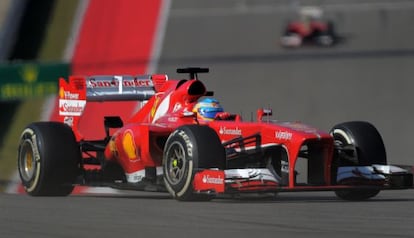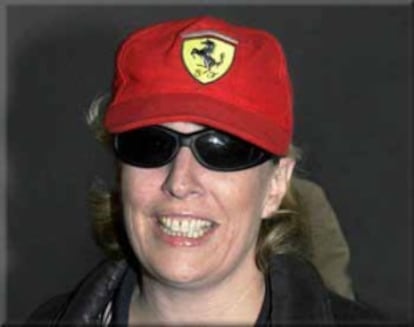The titanic rebuilding of Ferrari
Thanks to some serious investment, the Italian team is hoping to return to glory


On October 10, 2001, UK journalist Yvonne Ridley landed at Heathrow airport, after having spent 10 days being held captive by the Taliban in Afghanistan. When Ridley appeared in the terminal, having been flown in from the Emirates, she was wearing sunglasses and a red baseball cap, which had the Ferrari logo emblazoned on the front of it. The photos of her were seen across the world, and of course they also made their way to the Italian company’s headquarters in Maranello, where the heads of marketing received plenty of congratulatory messages — albeit for something that they never would have dreamed up in a million years. The episode is a good example of the power of the image of the Ferrari brand, perhaps the most universally recognized of all those to emerge from the world of Formula 1 racing.
“We are the only team that is condemned to win,” its members are often heard to say, from president Luca di Montezemolo, to star driver Fernando Alonso. This permanent need, however, is more an argument used for communication purposes, rather than a genuine imperative on the part of the company, which this year posted the best results in its history, with an increase of revenue of 6.7 percent and total profits of 178.8 million euros. According to Ferrari’s marketing department, there is no direct relationship between the success of the Formula 1 division and the sale of its luxury sports cars.
The superiority and the muscle of the brand has been proved time and again, but at the same time, its most visible facet, i.e. its Formula 1 team, is under all kinds of pressure — not just sporting, but also political. In Italy, there are two sacred pillars of sport: the national soccer team, and Ferrari. And both of them are going through difficult times. After overseeing the most glorious era of an F1 team between 2000 and 2004, Luca de Montezemolo is only interested in winning. Until now his modus operandi has been conditioned by other factors.
When the triumvirate made up of Jean Todt (general manager), Ross Brawn (technical director) and Michael Schumacher (seven-time world champion) was broken up in 2004, the Italian executive was forced to reorganize Ferrari. Up until that point, Todt held much of the decision-making power within the Italian outfit, thanks in no small part to the amount of wins he had overseen. The Frenchman even went on to become the CEO of the company, a position he held until 2009.

For Montezemolo, having someone else at the helm was an advantage, given that the responsibility fell to Todt should the team’s performance on track fall short of expectations. So when they were casting about for a new team principal, there were two options: continue with the same model, and promote Ross Brawn, or give Stefano Domenicali an opportunity. Montezemolo opted for the latter, based on three reasons: the Italian was the cheaper of the pair; promoting Domenicali gave Montezemolo back the power that Todt had come to wield; and it was the first step toward the “Italianizing” of the team, a process that Ferrari wanted to complete in time for the celebration of the 150th anniversary of the unification of Italy in 2011.
But now it has been six years since a driver dressed in red took the drivers’ championship (Kimi Raikkonen, in 2007). During all of that time, Ferrari has constantly reorganized its structure with the aim of finding the formula it needs to get back on top. Right now, however, it is taking that challenge more seriously than ever.
“We have spent the last 10 years improving the industrial area, our products. And for the last two years, we have been focused on F1,” sources at the Ferrari workshop explain. That task has involved the recruitment of engineers, and a complete modernization of its facilities.
“I am very lucky to be arriving at Ferrari now that they have made this titanic investment.” The man who uttered that sentence is James Allison, the new technical director for Ferrari, who joined the team several months ago from Lotus. While Allison is the most visible face of this new chapter in Ferrari’s history, in technical terms, the biggest development is their new wind tunnel, which is now up and running and ready for 2014, when a raft of new regulations and engine specifications could help them back up to the top.
Tu suscripción se está usando en otro dispositivo
¿Quieres añadir otro usuario a tu suscripción?
Si continúas leyendo en este dispositivo, no se podrá leer en el otro.
FlechaTu suscripción se está usando en otro dispositivo y solo puedes acceder a EL PAÍS desde un dispositivo a la vez.
Si quieres compartir tu cuenta, cambia tu suscripción a la modalidad Premium, así podrás añadir otro usuario. Cada uno accederá con su propia cuenta de email, lo que os permitirá personalizar vuestra experiencia en EL PAÍS.
¿Tienes una suscripción de empresa? Accede aquí para contratar más cuentas.
En el caso de no saber quién está usando tu cuenta, te recomendamos cambiar tu contraseña aquí.
Si decides continuar compartiendo tu cuenta, este mensaje se mostrará en tu dispositivo y en el de la otra persona que está usando tu cuenta de forma indefinida, afectando a tu experiencia de lectura. Puedes consultar aquí los términos y condiciones de la suscripción digital.
Últimas noticias
Reinhard Genzel, Nobel laureate in physics: ‘One-minute videos will never give you the truth’
Pinochet’s victims grapple with José Antonio Kast’s rise in Chile
From digital curfews to blocking apps: How technology experts protect their children online
Why the price of coffee has skyrocketed: from Brazilian plantations to specialty coffee houses
Most viewed
- Pablo Escobar’s hippos: A serious environmental problem, 40 years on
- Why we lost the habit of sleeping in two segments and how that changed our sense of time
- Trump’s obsession with putting his name on everything is unprecedented in the United States
- Charles Dubouloz, mountaineering star, retires at 36 with a farewell tour inspired by Walter Bonatti
- The Florida Keys tourist paradise is besieged by immigration agents: ‘We’ve never seen anything like this’








































